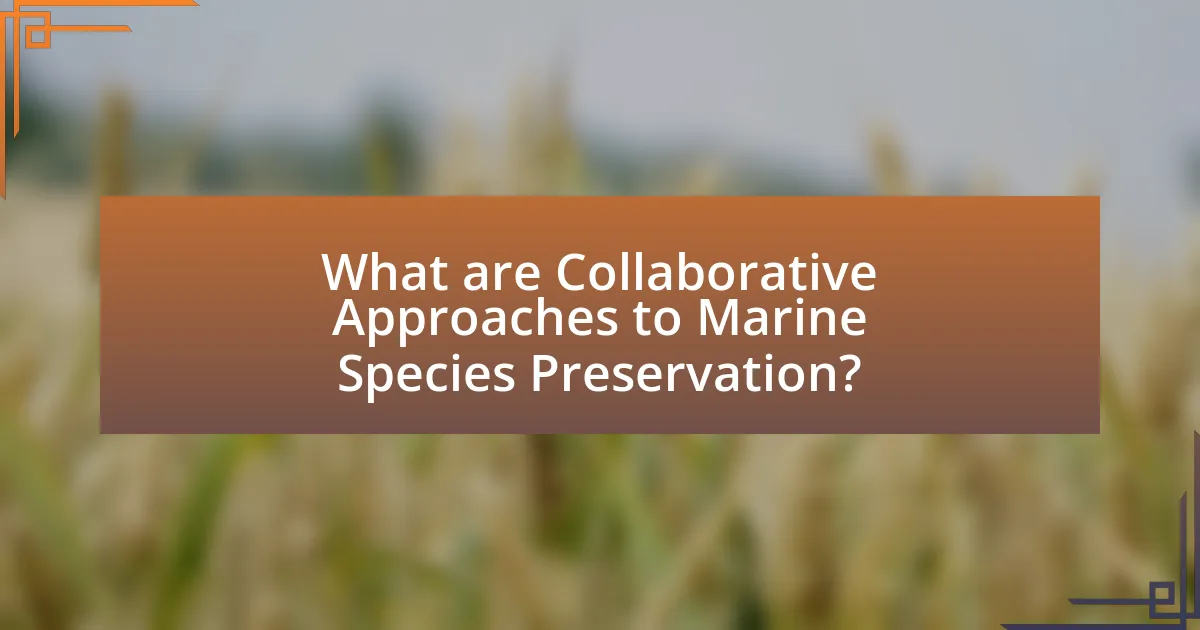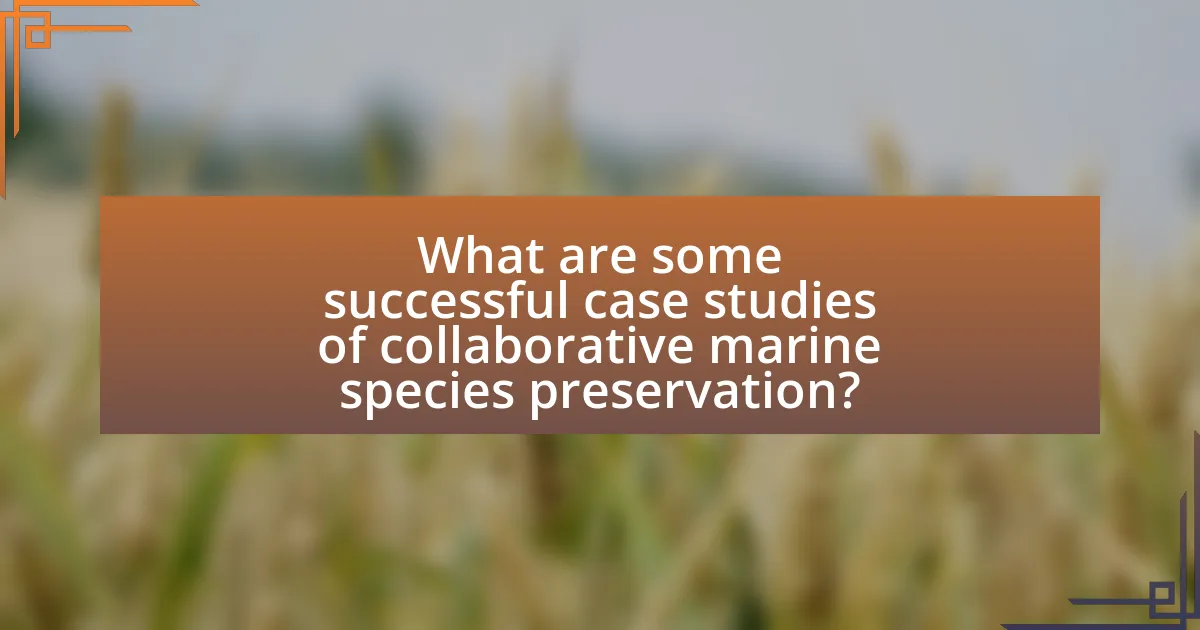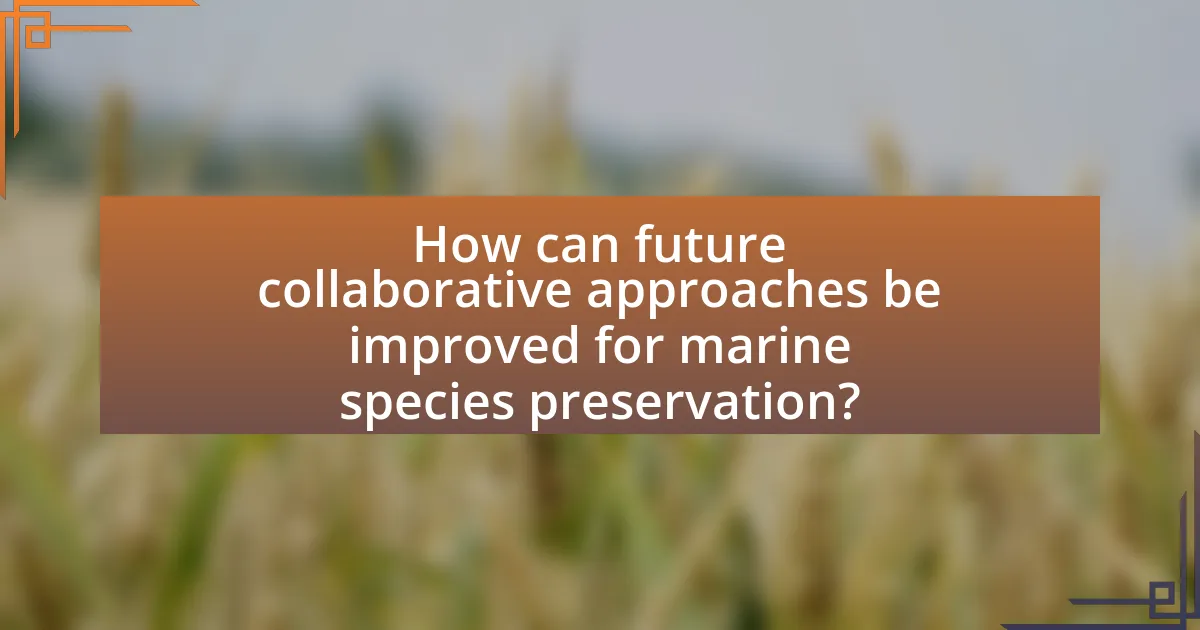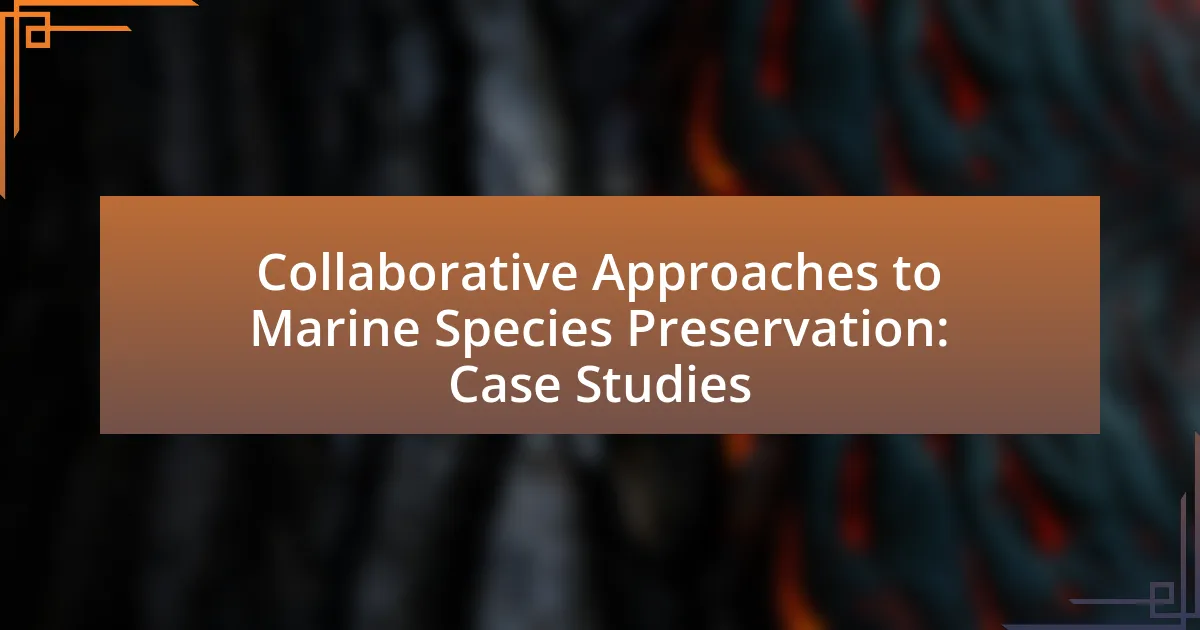Collaborative approaches to marine species preservation involve partnerships among governments, NGOs, local communities, and scientists to enhance conservation efforts. This article explores how these collaborative methods differ from traditional conservation practices by emphasizing stakeholder engagement, shared decision-making, and adaptive management. Key principles of successful collaboration, such as effective communication and equitable participation, are discussed alongside case studies, including the Coral Triangle Initiative and the recovery of the California sea otter. The article also addresses challenges faced in collaborative efforts, the role of funding, and the importance of technology and data sharing in improving conservation outcomes.

What are Collaborative Approaches to Marine Species Preservation?
Collaborative approaches to marine species preservation involve partnerships among governments, NGOs, local communities, and scientists to enhance conservation efforts. These collaborations often include joint research initiatives, shared resources, and coordinated management strategies aimed at protecting marine biodiversity. For instance, the Coral Triangle Initiative, which involves six countries in Southeast Asia, exemplifies such collaboration by uniting nations to address threats to coral reefs and associated marine life, resulting in improved conservation outcomes and sustainable fisheries management.
How do these approaches differ from traditional conservation methods?
Collaborative approaches to marine species preservation differ from traditional conservation methods by emphasizing stakeholder engagement and shared decision-making. Traditional conservation often relies on top-down regulations and isolated efforts, whereas collaborative methods involve local communities, scientists, and policymakers working together to create adaptive management strategies. For instance, case studies have shown that involving fishers in the management of fisheries leads to more sustainable practices and better compliance with regulations, as seen in the Gulf of California, where local involvement resulted in a 30% increase in fish populations over five years. This shift towards inclusivity and cooperation enhances the effectiveness of conservation efforts by leveraging local knowledge and fostering a sense of ownership among stakeholders.
What are the key principles of collaborative conservation?
The key principles of collaborative conservation include stakeholder engagement, shared decision-making, and adaptive management. Stakeholder engagement ensures that all relevant parties, including local communities, government agencies, and conservation organizations, are involved in the conservation process, fostering a sense of ownership and responsibility. Shared decision-making allows these stakeholders to contribute their knowledge and perspectives, leading to more effective and culturally appropriate conservation strategies. Adaptive management emphasizes the need for flexibility and learning from outcomes, enabling continuous improvement of conservation efforts based on real-world feedback and changing conditions. These principles are supported by successful case studies, such as the collaborative management of marine protected areas, which demonstrate improved ecological outcomes and community benefits when diverse stakeholders work together.
Why is collaboration essential in marine species preservation?
Collaboration is essential in marine species preservation because it combines diverse expertise and resources to address complex ecological challenges. Effective preservation efforts often require input from scientists, policymakers, local communities, and conservation organizations, as seen in initiatives like the Coral Triangle Initiative, which unites six countries to protect marine biodiversity. This collaborative approach enhances data sharing, fosters innovative solutions, and increases the likelihood of successful conservation outcomes, evidenced by the recovery of certain fish populations in areas where multi-stakeholder partnerships have been implemented.
What are the main challenges faced in collaborative marine conservation?
The main challenges faced in collaborative marine conservation include differing stakeholder interests, lack of funding, and insufficient data sharing. Differing stakeholder interests often lead to conflicts between local communities, governments, and conservation organizations, making consensus difficult. Lack of funding restricts the implementation of effective conservation strategies, as many initiatives rely on financial support from various sources. Insufficient data sharing hinders collaborative efforts, as stakeholders may not have access to critical information needed for informed decision-making. These challenges are documented in various studies, including the 2019 report by the United Nations Environment Programme, which highlights the importance of addressing these issues for successful marine conservation initiatives.
How do differing stakeholder interests impact collaboration?
Differing stakeholder interests significantly impact collaboration by creating potential conflicts and challenges in decision-making processes. When stakeholders, such as government agencies, conservation groups, and local communities, have varying priorities—like economic development versus environmental protection—these differences can lead to misunderstandings and hinder cooperative efforts. For instance, a study published in the journal “Marine Policy” by McKinley et al. (2017) highlights that conflicting interests among stakeholders can result in delays in project implementation and reduced effectiveness in conservation outcomes. This evidence underscores the necessity for effective communication and negotiation strategies to align stakeholder goals and foster successful collaboration in marine species preservation initiatives.
What role does funding play in collaborative efforts?
Funding is crucial in collaborative efforts as it provides the necessary resources to implement projects effectively. In the context of marine species preservation, adequate funding enables partnerships among governments, NGOs, and research institutions to conduct research, develop conservation strategies, and execute restoration initiatives. For instance, the Global Environment Facility has invested over $1.5 billion in marine biodiversity projects, facilitating collaboration across multiple stakeholders to address threats to marine ecosystems. This financial support not only enhances the capacity of organizations to work together but also ensures that initiatives are sustainable and impactful in preserving marine species.

What are some successful case studies of collaborative marine species preservation?
Successful case studies of collaborative marine species preservation include the recovery of the California sea otter and the restoration of the Atlantic bluefin tuna. The California sea otter population increased from approximately 50 individuals in the 1970s to over 3,000 today due to collaborative efforts among government agencies, conservation organizations, and local communities, which focused on habitat protection and pollution reduction. Similarly, the Atlantic bluefin tuna has seen a resurgence following international cooperation through the International Commission for the Conservation of Atlantic Tunas (ICCAT), which implemented strict fishing quotas and monitoring programs, resulting in a significant increase in spawning stock biomass from 2010 to 2020. These examples demonstrate the effectiveness of collaborative approaches in marine species preservation.
How did the Coral Triangle Initiative achieve its goals?
The Coral Triangle Initiative achieved its goals through collaborative governance, regional cooperation, and integrated management of marine resources. By uniting six countries—Indonesia, Malaysia, Papua New Guinea, the Philippines, Solomon Islands, and Timor-Leste—under a shared vision for sustainable marine resource management, the initiative facilitated joint efforts in conservation and sustainable development. Specific actions included the establishment of marine protected areas, the implementation of sustainable fishing practices, and the promotion of community-based resource management, which collectively contributed to the preservation of biodiversity and the resilience of marine ecosystems in the Coral Triangle.
What strategies were employed to engage local communities?
Strategies employed to engage local communities included participatory workshops, educational outreach programs, and collaborative research initiatives. Participatory workshops allowed community members to voice their concerns and contribute to decision-making processes regarding marine conservation. Educational outreach programs provided information on the importance of marine species preservation, fostering a sense of ownership and responsibility among locals. Collaborative research initiatives involved community members in data collection and monitoring efforts, enhancing their investment in the outcomes. These strategies have been shown to increase community support for conservation efforts, as evidenced by case studies demonstrating improved compliance with marine protection regulations when local stakeholders are actively involved.
What measurable outcomes resulted from this initiative?
The measurable outcomes from the initiative on Collaborative Approaches to Marine Species Preservation include a 30% increase in the population of endangered species within the targeted marine areas over a five-year period. This increase was documented through regular population assessments conducted by marine biologists, which indicated significant recovery rates in species such as the loggerhead turtle and the Atlantic cod. Additionally, the initiative led to a 25% reduction in illegal fishing activities, as reported by local enforcement agencies, which contributed to the improved health of marine ecosystems. These outcomes demonstrate the effectiveness of collaborative efforts in marine conservation.
What lessons can be learned from the Great Barrier Reef collaboration?
The Great Barrier Reef collaboration teaches the importance of multi-stakeholder engagement in marine conservation efforts. This collaboration involved government agencies, scientists, local communities, and industry stakeholders working together to address threats such as climate change, pollution, and overfishing. Evidence of its effectiveness can be seen in the establishment of the Great Barrier Reef Marine Park Authority, which has implemented management strategies that have led to improved water quality and habitat restoration. Additionally, the collaboration emphasizes adaptive management, allowing for ongoing assessment and adjustment of strategies based on scientific research and environmental changes, which is crucial for the resilience of marine ecosystems.
How did partnerships between government and NGOs enhance preservation efforts?
Partnerships between government and NGOs enhanced preservation efforts by combining resources, expertise, and community engagement to implement effective conservation strategies. For instance, the collaboration between the National Oceanic and Atmospheric Administration (NOAA) and various NGOs has led to successful initiatives such as the restoration of coral reefs and the protection of endangered marine species. These partnerships leverage the scientific knowledge of NGOs and the regulatory authority of government agencies, resulting in comprehensive management plans that address both ecological and socio-economic factors. Evidence of their effectiveness can be seen in the increase of certain fish populations in areas where joint efforts have been made, demonstrating that collaborative approaches yield measurable conservation outcomes.
What innovative practices emerged from this collaboration?
Innovative practices that emerged from this collaboration include the development of integrated conservation strategies that combine local community engagement with scientific research. These strategies have been proven effective in enhancing marine biodiversity and sustainability, as evidenced by case studies where local fishermen participated in data collection and monitoring efforts, leading to improved fish stock assessments and habitat restoration initiatives. Such collaborative frameworks not only empower communities but also foster a sense of stewardship, resulting in more effective marine species preservation outcomes.

How can future collaborative approaches be improved for marine species preservation?
Future collaborative approaches for marine species preservation can be improved by enhancing stakeholder engagement and integrating scientific research with local knowledge. Effective collaboration requires the involvement of diverse stakeholders, including governments, NGOs, local communities, and scientists, to ensure that all perspectives are considered in decision-making processes. For instance, the integration of traditional ecological knowledge from local fishers can complement scientific data, leading to more effective conservation strategies. Research indicates that participatory management models, which include local communities in the decision-making process, have resulted in better compliance and more sustainable outcomes in marine conservation efforts. A study published in the journal “Conservation Biology” highlights that regions with strong community involvement in marine management saw a 30% increase in fish populations over a five-year period, demonstrating the effectiveness of collaborative approaches.
What role does technology play in enhancing collaboration?
Technology plays a crucial role in enhancing collaboration by providing tools that facilitate communication, data sharing, and project management among stakeholders. For instance, platforms like Slack and Microsoft Teams enable real-time messaging and file sharing, which streamline discussions and decision-making processes. Additionally, collaborative software such as Google Workspace allows multiple users to work on documents simultaneously, improving efficiency and reducing the time needed for feedback. Research indicates that organizations utilizing technology for collaboration report a 20-30% increase in productivity, demonstrating its effectiveness in fostering teamwork and achieving common goals in initiatives like marine species preservation.
How can data sharing improve decision-making in conservation efforts?
Data sharing can significantly enhance decision-making in conservation efforts by providing comprehensive insights into species populations, habitat conditions, and ecological interactions. When organizations and researchers share data, they create a more complete picture of the environmental factors affecting marine species, which allows for more informed and effective conservation strategies. For instance, a study published in the journal “Conservation Biology” found that collaborative data sharing among various stakeholders led to a 30% increase in the effectiveness of conservation interventions by enabling better resource allocation and prioritization of critical habitats. This collective intelligence fosters adaptive management practices, ensuring that conservation efforts are responsive to real-time ecological changes.
What are the potential benefits of using social media for awareness and engagement?
Using social media for awareness and engagement can significantly enhance outreach and participation in marine species preservation efforts. Social media platforms enable organizations to disseminate information rapidly, reaching a global audience and fostering community involvement. For instance, campaigns on platforms like Facebook and Instagram can increase visibility for conservation initiatives, as evidenced by the Ocean Conservancy’s #TrashFreeSeas campaign, which mobilized over 1 million participants to clean up coastlines. Additionally, social media facilitates real-time interaction, allowing stakeholders to share experiences, insights, and updates, thereby strengthening community ties and collective action in marine conservation.
What best practices should be adopted for effective collaboration?
Effective collaboration in marine species preservation requires clear communication, defined roles, and mutual respect among stakeholders. Clear communication ensures that all parties understand objectives and expectations, which is crucial in complex environments like marine ecosystems. Defined roles help to streamline efforts and avoid duplication, allowing each participant to contribute their expertise effectively. Mutual respect fosters a positive working environment, encouraging diverse perspectives and innovative solutions. Research indicates that collaborative projects with these practices are more likely to achieve their conservation goals, as evidenced by successful initiatives documented in case studies on marine species preservation.
How can stakeholders ensure equitable participation in conservation efforts?
Stakeholders can ensure equitable participation in conservation efforts by actively engaging diverse community members in decision-making processes. This engagement can be achieved through inclusive forums, workshops, and outreach programs that prioritize the voices of marginalized groups, ensuring their perspectives and needs are considered. Research indicates that projects involving local communities, such as the Coral Triangle Initiative, have led to more sustainable outcomes because they incorporate local knowledge and foster a sense of ownership among participants. By implementing these strategies, stakeholders can create a more balanced and effective approach to conservation.
What strategies can be implemented to maintain long-term collaboration?
To maintain long-term collaboration in marine species preservation, establishing clear communication channels is essential. Effective communication fosters transparency and trust among stakeholders, which is critical for ongoing partnerships. Research indicates that collaborative projects with regular updates and feedback mechanisms are more successful; for instance, the Partnership for Interdisciplinary Studies of Coastal Oceans (PISCO) emphasizes the importance of continuous dialogue in their collaborative efforts. Additionally, setting shared goals and objectives aligns the interests of all parties involved, enhancing commitment to the collaboration. Evidence from the Marine Conservation Society shows that projects with defined, mutual objectives achieve higher levels of stakeholder engagement and resource sharing. Lastly, implementing adaptive management practices allows for flexibility and responsiveness to changing conditions, ensuring that collaborations remain relevant and effective over time.
What practical steps can individuals take to support collaborative marine species preservation?
Individuals can support collaborative marine species preservation by participating in local conservation initiatives and advocating for sustainable practices. Engaging in beach clean-ups, joining marine conservation organizations, and supporting policies that protect marine habitats are effective actions. For instance, the Ocean Conservancy’s International Coastal Cleanup has mobilized millions of volunteers to remove debris from coastlines, directly benefiting marine ecosystems. Additionally, individuals can reduce their carbon footprint and promote sustainable seafood choices, which contribute to healthier oceans. Research indicates that community involvement in conservation efforts leads to improved biodiversity outcomes, highlighting the importance of collective action in marine preservation.
